Wondering how you can speed up your software development project? Create proper kick-off documentation! This one step can significantly improve the chances of the success of your project. What good kick-off documentation looks like? Why should you create them, and who gains from such documentation? How do you create them? Read this guide for answers to all these questions.
Good kick-off documentation can accelerate the very first steps of your project, prepare the ground for further management and improve the efficiency of the development process.
This article will explain the notion of kick-off documentation and what are the best practices of preparing and maintaining such documentation.
What is kick-off documentation?
Kick-off documentation is a kind of an abbreviation for a ‘document for the project team kick-off meeting’. It is a document with a checklist that includes the necessary points that have to be addressed before any project work begins.
Good kick-off documentation offers relevant information to the project team and it helps the stakeholder to turn the project into a success.
Read also: How To Run A Kickoff Meeting - 10 Tips
We believe that kick-off documentation helps the PM and the project team. It should also help with the project architecture and business analysis. It aids UI designers, developers and reviewers in the process of software development. Testers and DevOps engineers can also find it useful.
Perfect kick-off documentation should contain project definition, scope and all the requirements. It should provide architectural and technical environment details. You also need to include design details and testing plans.
Why you need kick-off documentation?
You may be wondering why such documentation is such an essential part of a successful project. While it may be tempting to go straight into development it pays to take a bit more time in the beginning to figure out the details. Apart from the structure and organisational benefits kick-off documentation also provides:
- a checklist of things that need to be done for both the client and the provider
- it shortens the time of communicating the same things at the beginning of the project
- the client will immediately be informed about the most problematic tasks, which will help them prioritise the next step
- thanks to the kick-off documentation each stage of the project will go smoothly
Try our developers.
Free for 2 weeks.
No risk. Just results. Get a feel for our process, speed, and quality — work with our developers for a trial sprint and see why global companies choose Selleo.
Good kick-off documentation checklist

The first point of any kick-off documentation is choosing a person-of-contact on each side. This will ensure that everybody knows who to contact when a problem occurs or something needs to be clarified.
Then you should think about the form of communication of progress - whether you prefer it via text or call. You can schedule regular meetings like dailies or weeklies so everybody can stay up-to-date.
When you have an internal development team, make sure to schedule a pair programming with the external team. This will allow the teams to get to know each other’s workflow, which will have a positive impact on further cooperation.
Another point you should take into consideration is preparing a structure diagram of your future system that contains a mapping of the apps that create the system. You can also specify who is the owner of each domain or part of the system so any new developer will know who to contact.
Next would be to build a glossary in your application so everyone on the team uses consistent wording and there are no ambiguities about naming conventions. When planning the development, secure enough time for automated test coverage on the critical parts of the system.
Remember to add contract test tools like Pact. Pact is a code-first tool for testing HTTP and message integrations using a contract test without the need for integration tests.
The last point of the checklist is the cultural fit. Even though it might sound silly, cultural fit it what truly simplifies the communication and reduces unnecessary traction from both sides. Some sayings or behaviours may be treated as rude in other countries, so it is nice to research that prior to the project kick-off. A good fit will make working on the project pleasurable and limit stress and misunderstandings.
‘Test’ your documentation
When you finally prepare your documentation it is important to validate it before starting the project. If your client requests actions that need to be performed and are not included in the existing documentation - make sure to add them in.
Testing the documentation means to verify the checklist at the beginning of every new project - it will help you extend and improve the list for the future.
It also means being flexible and adjusting the list to the needs of each individual client.
Keep your documentation up-to-date
It is crucial to keep your documentation up-to-date. After the first months of your last project kick-off, it is a good idea to make changes to the list and update it.
Although it might seem time-consuming and redundant it will most definitely pay off in the future. Well-maintained documentation can be used throughout the years while also providing a point of reference.
Summary
At Selleo, we believe that good kick-off documentation leads to a successful project. Even though it might seem unnecessary and time-consuming it tremendously helps the team to stay on track and keep to work organised. It also aids our clients in creating a checklist of things to be done before the development process and to collect requirements in one place.
Our teams work within the Agile methodology, which makes them highly motivated and engaged. If you want to find out more about that read our post on How to build high-performance Agile teams.
And if you want to work with an Agile team, that will provide you with great kick-off documentation, contact us!





